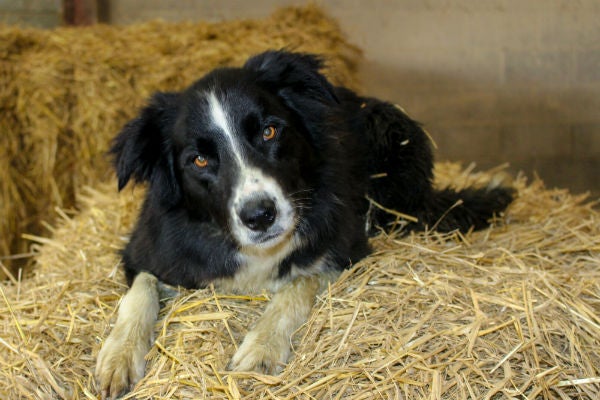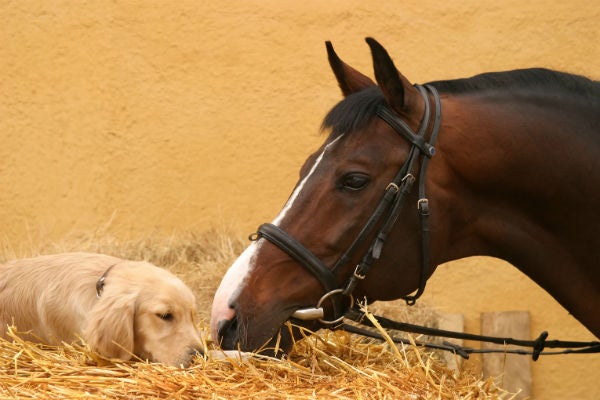
I can count on one hand the number of barns I’ve been to that did not have a resident barn dog. Barns and dogs are the ultimate pairing. Dogs have helped deter vermin and would-be predators since humans first started keeping livestock thousands of years ago. And, we like having our dogs with us, especially when we are outdoors.
Barns, however, are not always the safest place for dogs.
Whether you own a barn, frequently visit a barn with your dog, or compete in sports such as Barn Hunt or herding competitions, there are a few commands and behaviors your dog needs to know to keep him, you, and any barn animals safe.
1. Come
“Come” might seem like the most basic of all commands, but it can also be the hardest command to enforce. A dog that comes willingly in the house or a field might hesitate if presented with a particularly alluring alternative, like a squawking chicken or a barn cat. Practice the “come” command until your dog comes, even when faced with exciting distractions.
2. Stay
Dogs might be allowed in the barn, but that does not mean you want them underfoot at all times, especially when you are working with a large animal like a horse, or even with a power tool. A dog that stays until released from the command allows you to carry out your chores without having to worry that your dog will stick herself in the middle of a dangerous situation — or worse, put you in a dangerous situation.
3. Drop It
Barns are full of fascinating objects. Manure, dead rodents, decomposing straw, bits of leather, screws, hoof trimmings – the list of dangerous and disgusting objects is long, and you need to be able to get those objects out of your dog’s mouth quickly. “Drop it” can be turned into a fun game during training sessions, where one toy is traded for another or for a treat, and is an essential command for any barn dog.
4. Leave It
“Drop it” is an important command, but preventing the object from entering your dog’s mouth in the first place is even better. “Leave it” teaches your dog to avoid an interesting object. You can train “leave it” by presenting your dog with a fun toy or treat, and rewarding him with a different toy or treat when he ignores the first object on your command.
5. Down
During an AKC-sponsored training class, an instructor once explained the value of the “long down.” The down position is a calmer position than standing or sitting. Placing your dog in a down, and making sure he stays in a down until released, is a great technique to establish trust and authority. It also means that you can sit and clean tack without having to worry about where your dog has wandered off to.

6. Go to Mat
The “go to” command can refer to a mat, a blanket, a spot, or a crate, as long as it is a location that your dog associates with safety and calm. If you bring your dog around livestock or horses, then there is always a risk that something unexpected could happen, like an escaped or frightened animal. If your dog is trained to go to an out-of-the-way location on command, you can easily send him to safety while you deal with the situation. This is especially useful in circumstances where you may not have time to get your dog out of harm’s way yourself. “Go to” can also be used to give your dog a break from the excitement of the barn, or perhaps to give you a break from supervision.
7. Sit
“Sit,” like “down,” arrests your dog’s motion. It is also one of the first commands most dogs learn, and a great way to grab your dog’s attention. It can be used in conjunction with other commands, or as a way to ensure that your dog is focused on you.
8. Leash Manners
The best way to keep your dog out of trouble is to keep her on a leash. Even dogs that are well mannered off leash need to have excellent leash manners in a barn setting, especially if it is a new setting. Leashes allow you to introduce your dog to new environments and animals without the risk of losing control, and a dog that can also be temporarily tied up is a great asset in a barn. Train your dog to walk calmly on a leash, even when passing exciting animals, smells, and sounds.
9. Crate Manners
One of the most useful things you can teach your barn dog is to love her crate. If you travel to horse, livestock, or dog shows on a regular basis, a crate-trained dog can be left unattended in a safe location without stressing out you, the dog, or any neighboring animals. And the ability to put your dog in a crate for a few minutes while you deal with a dangerous situation could save your dog’s life.
10. Quiet
Barking is a natural dog behavior that can be very useful. A barking barn dog can alert you to an unwanted intruder in the barn, or let you know that there is something wrong. A dog that barks incessantly, however, can put unwanted stress on your other animals or guests. Training your dog to be quiet can be tricky. Talk to your trainer about the best technique for your dog, or practice distraction-training techniques like the “touch” command to break your dog out of a barking cycle.
As you spend more time in the barn with your dog, you will probably come up with more commands that you will use to help keep your dog safe – or make your life easier. Try training your dog to bring you objects like lead ropes or brushes on command, or take a herding class and let your dog help you round up the chickens. No matter what you do, however, keep your safety and your dog’s at the front of your mind. Once you’ve mastered these commands, see about getting your dog Farm Dog Certified.


